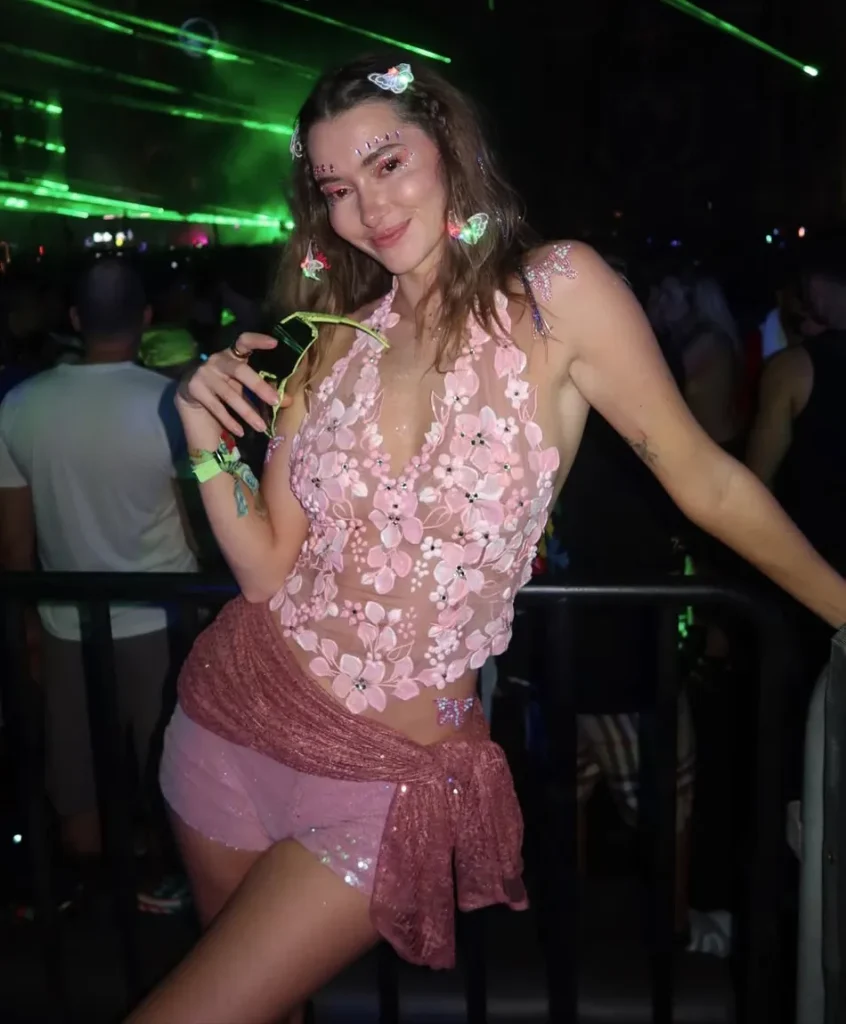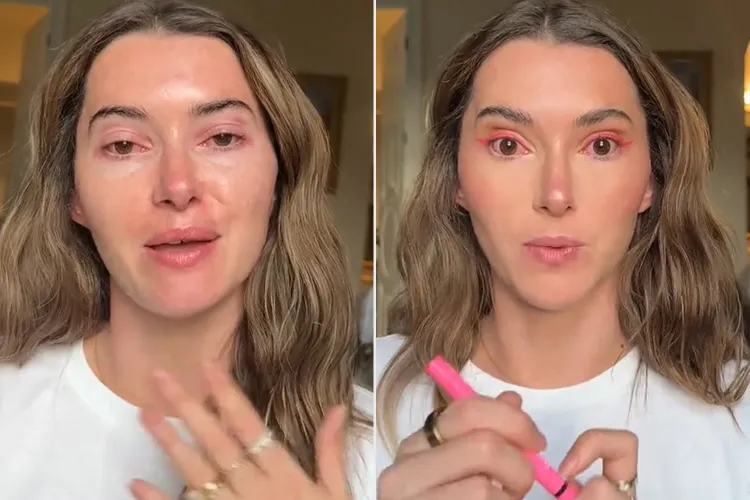U.K. Influencer Madeleine White Slammed for Attending Orlando Rave with Pink Eye — and Covering It Up with “Sparkles and Sunglasses”
British influencer Madeleine White is facing a wave of backlash after sharing a video in which she admitted to attending an Orlando rave while suffering from pink eye, sparking fierce criticism from both fans and medical professionals. Known for her vibrant personality and bold beauty looks, White has built a loyal online following for her creative content and candid approach to fashion and self-expression. But this time, her openness may have crossed a line, as many viewers accused her of showing irresponsibility and disregard for public health.

The controversy began when White posted a now-viral TikTok clip showing her preparing for her birthday celebration at an Orlando rave. In the video, the 29-year-old creator openly explained that she was battling conjunctivitis — commonly known as pink eye — yet decided to attend the event anyway. She applied eye makeup, including sparkles, and completed the look with oversized sunglasses, joking that it was her “pink-eye chic” disguise for the night. Her caption, combined with her lighthearted tone, drew immediate attention and ignited an online firestorm.
The influencer, who boasts millions of followers across platforms, initially seemed to treat the situation playfully. “It’s my birthday, I have pink eye, but I’m not missing this rave,” she said in the clip, laughing as she showed herself applying glitter and mascara. The video quickly racked up hundreds of thousands of views and a flood of divided comments. While some fans found the clip humorous, many others were shocked and angered that she chose to attend a crowded event while visibly infected with a highly contagious condition.
Medical experts and everyday viewers alike pointed out the public health risks of attending social gatherings with conjunctivitis. The infection, which can be viral or bacterial, spreads easily through contact with contaminated surfaces or secretions. Dr. Rachel Gray, an ophthalmologist in London, explained to media outlets that pink eye “can spread through simple touch — it’s one of the most contagious mild infections out there.” She added that “attending public events while symptomatic, especially something like a rave where there’s close contact and shared surfaces, is not advisable.”

Viewers quickly echoed that sentiment online, flooding White’s comment sections with criticism. “Girl, you’re literally spreading pink eye like confetti,” one commenter wrote. Another said, “I love your content, but this is just irresponsible — people have immune conditions; you can’t just glam up a contagious infection.” Others expressed disappointment, saying they had admired White for her authenticity and creativity but found this particular decision careless.
The incident sparked a wider conversation about influencer accountability and how public figures navigate illness in the age of constant content creation. In a culture where transparency and relatability are celebrated, White’s willingness to show her condition on camera initially seemed refreshing. However, many noted that her choice to attend a public event while knowingly contagious blurred the line between honesty and recklessness.
Some users defended her, arguing that the backlash was disproportionate and that many people attend events while mildly ill. “She didn’t mean harm, she was just being real,” one supporter commented. Others pointed out that White was open about her condition and wore sunglasses, suggesting she was attempting to minimize exposure. Still, the majority of feedback remained critical, emphasizing that awareness doesn’t excuse poor judgment.
In the days following the viral clip, clips of White at the rave surfaced online, showing her dancing with friends under colorful lights and music. Her energy appeared unaffected, but her visibly irritated eye was noticeable even in the dim footage. Those images reignited the debate, with users questioning whether social media fame encourages creators to prioritize content over caution.

Madeleine White, who has not issued a formal apology or statement as of yet, has a long history of using humor to address personal or awkward moments. Her fans often praise her for breaking the perfectionism typically associated with influencer culture. But in this instance, her comedic framing clashed with growing public concerns around hygiene and social responsibility.
Critics have pointed out that such behavior contributes to a larger issue — the normalization of “pushing through” illness for the sake of engagement or appearances. “The influencer economy thrives on constant visibility,” said cultural analyst Sophie Warren. “Creators like Madeleine are under pressure to perform and stay relevant, even when they’re unwell. But that doesn’t absolve them from the responsibility of protecting others, especially when health is at stake.”
The backlash comes amid heightened awareness of contagious illnesses following global health crises in recent years. Social media users have grown more sensitive to public hygiene practices, and moments like this easily trigger broader concerns about community safety. For many, White’s decision felt symbolic of a larger cultural tension — between individual freedom and collective responsibility.
Despite the controversy, some followers continued to express empathy, noting that conjunctivitis, while unpleasant, is rarely serious and that White might have underestimated its contagiousness. “We’ve all made bad judgment calls when excited for an event,” one person wrote. “Maybe she thought makeup and sunglasses would be enough.” Others, however, argued that being an influencer means understanding the influence — and consequences — of one’s actions.
The influencer industry has long grappled with similar debates, where lifestyle creators face scrutiny for decisions that blur ethical or social boundaries. From promoting questionable products to glamorizing unhealthy habits, the pressure to stay “relatable” while maintaining an aspirational image often leads to controversy. In White’s case, her transparency — something that once helped build her brand — ironically fueled the criticism.
Her silence following the uproar has only added to speculation about whether she plans to address the issue publicly. Some observers believe she may wait for the backlash to fade, while others expect a reflective follow-up post. If past influencer crises are any indication, a statement acknowledging the criticism — and clarifying intentions — may eventually help restore trust among her audience.
The incident has also reignited conversations around how social media platforms amplify viral outrage. Within hours of White’s post, TikTok users were reposting clips with commentary, duets, and reaction videos dissecting her decision. Hashtags like #PinkEyeRave and #MadeleineWhite trended briefly, drawing millions of views. The virality demonstrated not only the power of TikTok’s algorithm but also the public’s fascination with influencer missteps.
Media outlets soon picked up the story, further intensifying the attention. While many framed it as a cautionary tale about health awareness, others approached it as an example of modern influencer culture gone too far — where shock value and transparency collide in unpredictable ways.
In a broader context, White’s pink-eye incident highlights how quickly the internet can shift from admiration to condemnation. Just weeks earlier, she was praised for her creative beauty tutorials and collaborations with major fashion brands. Now, her name is trending for an entirely different reason. It’s a reminder of how precarious public favor can be — especially in an era where every action is amplified, archived, and endlessly replayed online.
Observers also noted how gender dynamics often play into influencer backlash. Female creators, in particular, tend to face harsher criticism for health or appearance-related missteps. While this doesn’t excuse questionable choices, it does reflect how influencer behavior is often judged through a magnified lens of morality and responsibility. “It’s fair to hold people accountable,” one social media expert noted, “but the internet has a way of turning mistakes into spectacles. Sometimes, the outrage eclipses the lesson.”
As of now, it remains unclear whether White experienced any long-term consequences from the incident. Her recent posts suggest she has resumed her normal content routine, sharing beauty and fashion clips with no direct mention of the controversy. However, many viewers have continued to bring it up in her comment sections, ensuring that the episode lingers as a defining moment in her public narrative.
The incident serves as a reminder that influence comes with visibility — and visibility comes with responsibility. For creators like Madeleine White, whose authenticity and humor are central to their appeal, finding the balance between self-expression and social awareness is an ongoing challenge. What may have started as a lighthearted moment of self-deprecating humor has now become a public debate about health, ethics, and the blurred boundaries of digital celebrity.
In a time when audiences demand both honesty and accountability, even seemingly small decisions can ripple into massive online discussions. And for an influencer whose brand is built on connection and relatability, the lesson is as much about perception as it is about principle. Whether White chooses to address the situation further or quietly move on, her experience will likely be studied as yet another example of how the modern influencer landscape tests the limits of public patience — and the expectations of those who live their lives online.


